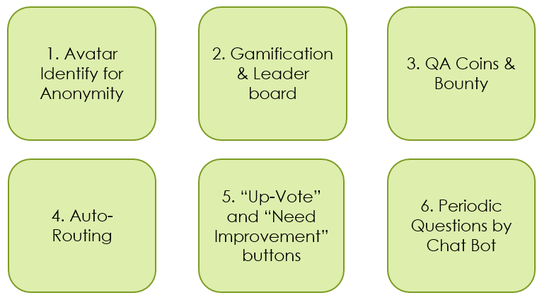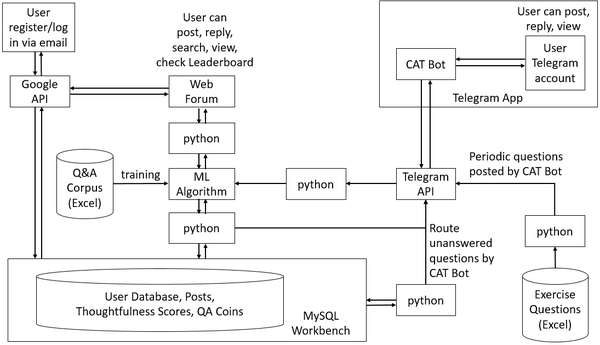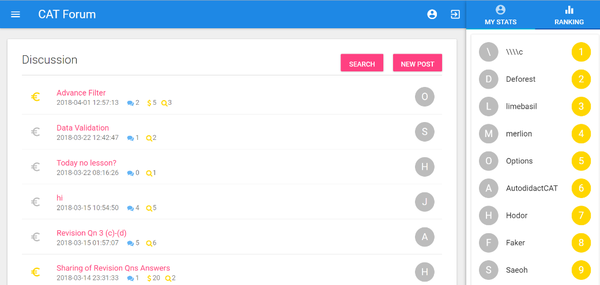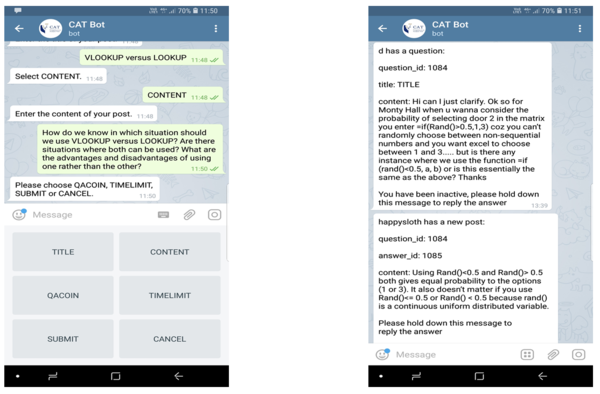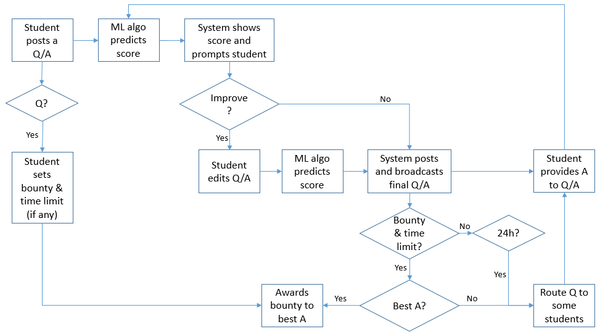Integrated Telegram and Web-based Forum with Automatic Assessment of Questions and Answers for Collaborative Learning
Contents
Summary
At SMU-SIS, a few of us have developed and implemented an integrated Telegram and Web-based Q&A Forum, capable of automatic thoughtfulness assessment of posts, using text mining and Natural Language Processing methodologies, coupled with intelligent engagement features, to facilitate student-driven participatory and collaborative learning. The system was developed for the undergraduate course COR1305 Spreadsheets Modeling and Analytics (formerly known as IS102 Computer as an Analysis Tool, or affectionately known as the CAT course). Thus, we have tentatively called the system CAT-IT, due to the long history of the CAT course.
Motivation
One key 21st century skill that students need to have is “the ability to ask and answer important questions, to critically review what others say about a subject, to pose and solve problems, to communicate and work with others in learning, and to create new knowledge and innovations” [1]. One way to develop such skills is through participatory learning which involves “cooperative learning tasks which are dialogic in nature and involve student-to-student interaction, rather than just teacher-student interaction.” [2].
Asynchronous online discussion forums have been used in many learning contexts to enable students to learn from their peers as a community, and it was mentioned in [3] that “perhaps the most important form of active learning is discussion.” Despite the popularity of using threaded forums in Learning Management Systems (LMS), it was argued that they “might not be the best technology to support the interactive and collaborative processes essential to a conversational model of learning” [4].
Several suggestions that future discussion environments should improve upon was provided by [5].
We target to overcome these ineffectiveness and facilitate active and meaningful online discussions for students at our university, assisting them to acquire this important skill and achieve better learning outcomes.
Student Engagement Features
The platform, CAT-IT, is a student-centric platform where the interactions in the form of asking questions and providing answers, are all student-driven. We have chosen this design as we believe that while the traditional tutor-student delivery is important, student-student interaction is also important for academic engagement as all participants are equals and there will be no power relationship issues which may hinder active discussions [6]. We have designed six special features to improve and maintain student engagement:
System Architecture and UI
System Process Flow
Publications
We have published the details of our platform and results of our implementation runs in the following papers.
We are working on more papers to further share our research and outputs.
Expression of Interest
We welcome other Institutions of Higher Learning (IHL) and organizations to explore how our platform can be adapted for implementation in their environment. Please contact Professor Michelle CHEONG (michcheong@smu.edu.sg) for further discussions.
Demo
References
[1] Trilling, B., & Fadel, C. (2009). 21st Century Skills: Learning for Life in Our Times. San Francisco, CA: John Wiley & Sons.
[2] Cahill, H., Coffey, J., Lester, L., Midford, R., Ramsden, R., & Venning, L. (2014). Influences on Teachers’ Use of Participatory Learning Strategies in Health Education Classes. In: Health Education Journal, 73(6), 702-713.
[3] Kember, D., & McNaught, C. (2007). Enhancing university teaching: lessons from research into award winning teachers. In: Abingdon, Oxforshire: Routledge, UK, C.
[4] Thomas, M.J.W. (2002). Learning with incoherent structures: the space of online discussion forums. In: Journal of Computer Assisted Learning, 18, 351-366.
[5] Gao, F., Zhang, T., & Franklin, T. (2013). Designing asynchronous online discussion environments: recent progress and possible future directions. In: British Journal of Educational Technology, 44(3), 469–483.
[6] Kassens-Noor, R. (2012). Twitter as a teaching practice to enhance active and informal learning in higher education: The case of sustainable tweets. In: Active Learning in Higher Education, 13, 9-21.
